Water Quality and Development Potential of the Western Bug River
Goals
The aim of our work package is the analysis of the present water quality of the Western Bug catchment and its development potential as a model region for heavily polluted and transnational rivers. We aim to develop measures and suitable option of actions for a sustainable and long-lasting rehabilitation of the river quality which also comprises aspects of future conditions (climate, political or land use changes). Following a first analysis of existing local information, we conducted three field campaigns, together with scientists and students from the Ukraine.
Besides an estimate of the positive effects of load reduction of the main polluters, special emphasis is laid on the role of the rivers hydromorphology and internal structures to support the self-purification. Further, we aim to analyse inputs and transport of potentially pathogenic bacteria focusing on antibiotic resistant isolates as a remarkable threat to humans’ health by e.g. contaminating drinking water resources. At the present, computer simulation models for matter transport and transformation in the river are developed on the basis of available and measured data.
Methods, Models and Approaches
The above mentioned problems require a comprehensive monitoring in order to evaluate the present situation and problems arising thereof, but more importantly to derive prospects and options for future action, developments and changes (climate, political, land use). The Ukraine already orientates itself towards the legislation of the European Water Framework Directive (EU WFD).
However, the recent assessment of water quality solely relies on physical and chemical indicators and the extent of monitoring effort and data quality differ widely from EU-WFD demands. Other more integrative monitoring approaches such as bioindication or an evaluation of the microbial situation are still missing. One exception is an already ongoing implementation of hydromorphological classification standards. Currently, first surveys were applied in the catchment of Western Bug (Western Bug Basin Department), an assessment method derived from German (LAWA-FS) and Slovakian experiences and approaches.

Measuring campaigns
The following aspects were covered by three measuring campaigns conducted in autumn 2009, spring 2010 and spring 2011:
- Water quality criteria (chemical, physical, probes, laboratory analyses)
- Heavy metal contamination (running water, sediments)
- Bioindication (using macroinvertebrates and the Perlodes / Aqem indication system)
- Hydromorphology field surveys (comparison of German and Ukrainian methods; on site and satellite image-based)
- Microbiology, hygienic situation, antibiotic resistances
Models of Matter Transport and Transformation
The acquired data were statistically analysed and submitted as joint publications, together with our Ukrainian partners. Current activities are focussed on more detailed analyses and especially modelling:
- Process oriented modelling of the running water system for better understanding and estimation of matter turno
- Process oriented modelling of Dobrotvir Reservoir using the ecological lake model SALMO [link http://hhbio.wasser.tu-dresden.de/projects/salmo/]
Results
Chemical Water Quality
Our results indicate a high organic and microbial contamination in the headwater of Western Bug, especially after the inflow of Poltva River (sample site 5) and the downstream Bug river (sample site 6-9,). This is primarily caused by the outdated and overloaded wastewater treatment plants (WWTP) of Lviv city and results also in an extremely high load of phosphate in the Poltva River. It is further related to a high biochemical oxygen demand (BOD) and a strong decrease of oxygen levels. In the headwaters of the Bug river (near Sasiv (1-4) high levels of nitrate indicate diffuse inputs from e.g. agricultural land use.
The LAWA framework concept for monitoring and the proposed distinction between background and orientation limit values were also considered (LAWA-AO 2007), but the more rigorous limit values resulted in limit exceedance for most stations. For example, the background limit value for NH4+-N was exceeded by measured concentrations at all stations (to 100 %), whereas the orientation limit value was exceeded at 14 stations (to 82 %). Further information is given by Ertel et al. (under revision).
Microbial Load
A high number of human-related bacteria (e.g. Escherichia coli) within the Poltva river and after its confluent contain serious health risks for the local population particularly within the pollution hot spots and because of their high amount of resistant strains.
In contrast, the Dobrotivir reservoir (sample site 10) has a relatively positive effect on the hygienic situation and overall water quality. Both amend after passage and residence time within the reservoir. However, comparably high levels of phosphate and nitrate remain further downstream (11-17), and further deposits occur from adjacent cities (WWTP, point sources) or agriculture land use (diffuse sources) resulting in a persisting phytoplankton bloom downstream of Dobrotvir reservoir.
Hydromorphological Situation
The hydromorphological situation is more positive compared to water quality criteria. A major proportion of river sections in both the Western Bug and the Polva River are only slightly to moderate modified in the overall classification. However, the comparison of historical river courses with current situation also indicates that to some extent substantial channel modification have been undertaken due to amelioration activities primarily in the headwater and in the meandering river sections. This partly led to high profile depths and erosion problems.
The Dobrotvir Reservoir divides the Bug River into two morphologically separated river sections. In contrast, smaller migration barriers occur very sporadically, similarly bank and bed stabilisation rarely occur. Deficits could be detected within riparian vegetation; which were widely absent or occurred jagged. Comparably near-natural conditions can be found downstream of the city Sokal and close to the border. Here, floodplain forests and active erosions (width, curvature) can be partly found.
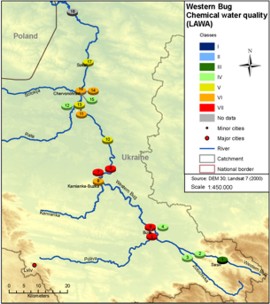
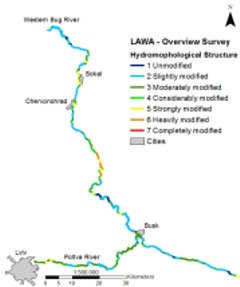
Fig. 1: Left: Results of water quality along the Western Bug River based on chemical – physical water quality criteria and thresholds given by LAWA 1998.
Right: The hydromorphological situation of Western Bug and Poltva River shows a wide range of only slightly to moderately modified overall classification according to the German LAWA Overview Survey (LAWA 2002). Data basis rely on publically available data (Google Earth, ArcView GIS, DGM; Sheifhacken et al., in prep.).
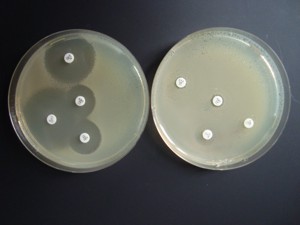
Fig. 2: Example of a susceptibility test to different antibiotics, an antibiogram. The petri dishes contain culture medium and antibiotic disk for two classes of commonly used antibiotics in clinics (beta-lactams= AML, AMC and CTX; fluoroquinolones= CIP). The left figure shows a non-resistant (i.e., susceptible) isolate: the growth of the bacterium was inhibited by the antibiotic disks.
The right petri dish shows a high resistant isolate: the bacterium was able to grow in contact with the antibiotic disk.
Related publications
Ertel A.-M., Lupo A. Scheifhacken N., Bodnarchuk T., Manturova O., Berendonk T. U., Petzoldt T. (under revision): Heavy load and high potential. Anthropogenic pressures and their impacts on the water quality along a lowland river (Western Bug, Ukraine). Environmental Earth Sciences, Special Issue.
Scheifhacken N, Haase U, Gram-Radu L, Kozovyi R, Berendonk TU (under revision): The comparison and suitability of assessment methods to identify the hydromorphological status of a transboundary river in the Ukraine. Environmental Earth Sciences Special Issue
Lupo A., Ertel A.-M., Scheifhacken N., Wolf O., Lueck C., Berendonk T. U. (in prep.) Heavily polluted freshwater: dissemination of drug and multi-drug resistant Escherichia coli in the Western Bug River, Ukraine
Conference proceedings
Berendonk T.U. (2010): Ausbildung von Antibiotikaresistenzen in Kläranlagen. Tagungsband, Vortrag, DWA-Landesverbandstagung Nord-Ost und Sachsen/Thüringen, 02-03 June 2010, Leipzig.
Berg K., Scheifhacken N., Abramyuk I., Ertel A.-M., Seiler C., Berendonk T.U. (2010): Under pressure – benthos communities along heavily polluted river stretches in the Western Bug, Ukraine. Poster, Jahrestagung der Deutschen Gesellschaft für Limnologie (DGL), 27 Sept.-01 Oct. 2010, Bayreuth.
Ertel A.-M., Rolinski S., Petzoldt T., Berendonk T.U. (2009): River water quality modeling within an integrated water management framework for the Western Bug region, Ukraine. Vortrag, 6th Symposium for European Freshwater Sciences, 18 Aug. 2009, Sinaia.
Haase U., Scheifhacken N., Kozovyi R., Gram-Radu L., Berendonk T.U. (2010): Die zwei Gesichter des Westlichen Bugs - Ergebnisse der Gewässerstrukturgüte nach LAWA und Ukrainischen Standards. Poster, Jahrestagung der Deutschen Gesellschaft für Limnologie (DGL), 27 Sept.-01 Oct. 2010, Bayreuth.
Petzoldt T., Scheifhacken N., Ertel A.-M., Lupo A., Seiler C., Manturvova O., Berendonk T. U. (2010) : A River Dam as Oxidation Pond? An Overview Over the Ukrainian Part of the Western Bug. Poster, Jahrestagung der Deutschen Gesellschaft für Limnologie (DGL), 27 Sept.-01 Oct. 2010, Bayreuth.
Rolinski S., Ertel A., Beilharz M., Petzoldt T., Berendonk T.U. (2009): Evaluation of priority water quality variables for an integrated water management for the Western Bug region (IWAS Ukraine). Vortrag, 23rd European Regional Conference, 18-21 May 2009, Lviv.
Scheifhacken, N., Berg K., Haase U., Kozovyi R., Gram-Radu L., Ertel A.-M., Lupo A., Seiler C., Petzoldt T., Berendonk T.U. (2010): Saprobie vs. Hydromorphologie – Benthosgemeinschaften im Einzugsgebiet des Westlichen Bugs (Ukraine). Vortrag, Jahrestagung der Deutschen Gesellschaft für Limnologie (DGL), 27 Sept.-01 Oct. 2010, Bayreuth.
Seiler C., Lupo A., Berendonk T.U. (2010): Co-selection of antibiotic and heavy metal resistant freshwater bacteria in the Western Bug (Ukraine). Poster, Jahrestagung der Deutschen Gesellschaft für Limnologie (DGL), 27 Sept.-01 Oct. 2010, Bayreuth.
Lupo A., Ertel A.M., Wolf O., Lueck C., Berendonk T.U. (2011): Multi-drug resistant /Escherichia coli/ from the Ukrainian Bug River. 4th Congress of European Microbiologists, FEMS, Geneva, Switzerland, June 26-30, 2011. A-291-0001-01562
Project Scientists
Prof. T. U. Berendonk (Project leader),
Dipl.Hydr. Anna-Maria Ertel,
Dipl.-Biol. Claudia Seiler,
Dr. Agnese Lupo,
Dr. Thomas Petzoldt,
Dr. Nicole Scheifhacken,
Dipl.-Biol. Olena Wolf
Address
Technische Universität Dresden
![]()
![]() Fakultät Forst-, Geo- und Hydrowissenschaften
Fakultät Forst-, Geo- und Hydrowissenschaften
Institut für Hydrobiologie
Helmholtzstr. 10
01062 Dresden
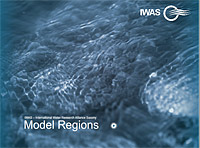
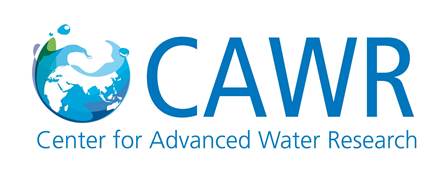


.png)
.png)
